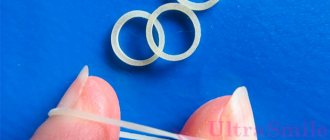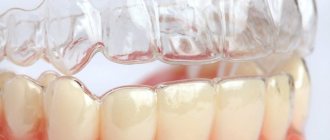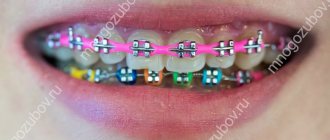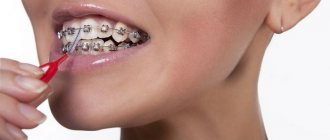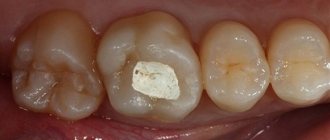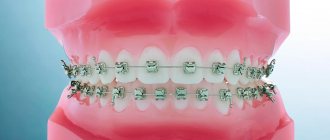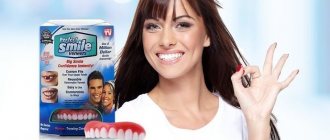Most orthodontic patients are primarily interested in how much braces cost . Having trusted a professional in everything else, few people at the treatment planning stage try to understand its smallest details. The attending physician himself, who has installed orthodontic systems more than once, considers such “little things” obvious. Therefore, “bracket bearers” sometimes have to deal with unexpected and sometimes unpleasant surprises. One of them is the need in some cases to wear elastic cords fixed on the clasps of braces around the clock.
Why are rubber bands placed on braces?
After installing braces, orthodontists resort to various additional devices aimed at improving treatment results. These include special orthodontic traction bands or elastic bands. They are made from hypoallergenic material with high strength and elasticity.
On a note!
Essentially, these are rings of different diameters that are installed on separate areas of braces and used as dental traction.
In orthodontics, there are several types of rubber bands for braces, each of which has its own functions. Together, they help speed up the process of correcting existing anomalies of the dentofacial apparatus by performing the following tasks:
- enhancing the therapeutic effect on the dentition;
- additional load on problem areas;
- guarantee of reliable fixation of the arch to the braces;
- reducing the time required to correct incorrect teeth position.
Elastic rings or rubber bands help the orthodontist have complete control over the bite alignment process.
Types of rubber bands
During the treatment process, the specialist can use different types of elastics, each of which has its own functional significance.
Elastic traction
We are talking about rings that are put on braces installed on both the upper and lower teeth. During fixation, the doctor ensures that the tension remains at an optimal level and is not too weak or too strong.
On a note!
These are the only elastics for braces that the patient can remove or put on independently, without the participation of a specialist.
The intermaxillary traction created is indicated for correcting malocclusion and uneven teeth at the end of the course of treatment. Elastic cords from Ormco, 3M Unitec and other manufacturers are popular.
Ligature rubber bands
These are small-diameter rings that are installed on each bracket to combine the plates with the arch into a single structure. They are used in ligature systems and are offered in various colors.
Multi-colored orthodontic rubber bands make the process of correcting uneven teeth more interesting for children and teenagers. Only a specialist fixes and removes ligature rings. Common brands of quality products:
- G&H Orthodontics;
- American Orthodontics;
- 3M Unitek.
Chain rings
Such rings are connected alternately, forming a kind of monochain. Rubber bands of this type are used to tighten teeth, that is, to eliminate wide interdental spaces.
A doctor must put chain rings on braces. The specialist fixes each rod in problem areas, and then connects them into a single chain using additional devices. Popular manufacturers:
- Ormco;
- Ortho Technology;
- 3M Unitec.
How are elastics installed?
The procedure is carried out by the attending physician, who chooses the method of fixing the elastic bands and the strength of their tension. The main principle: in order to professionally correct the bite , the traction created must be uniform on both sides of the jaws. In most cases, three schemes are used, each of which corresponds to a specific problem:
- V-fastening, when the teeth of different jaws are fastened in threes in the shape of a triangle, and two teeth are attracted to each other;
- box fastening, when several teeth of one block, located on the upper and lower jaws, are fastened in pairs and form a square or rectangle;
- a combined option, when for the complex movement of an entire block, the braces are connected according to a more complex pattern.
Since elastics are worn constantly, the patient should immediately carefully check the sensations they cause. In order not to disrupt the course of correction, rubber bands should not make it too difficult to open the mouth, interfere with conversation, impair diction and cause discomfort when chewing and swallowing food. If necessary, the attending physician will take care of correcting the detected deficiencies and reducing tension. But it is important to understand that the process of wearing elastics will not be easy.
Mounting methods
Many patients are interested in how to properly put elastic bands on braces. Only an orthodontist can answer this question correctly. It is he who fixes them, calculating the tension force of each element in order to achieve optimal treatment results in a short time without risk to the teeth.
There are two main ways to install rubber bands on braces:
- V-shaped - after fixation, the elastic looks like a tick due to the fact that on one jaw it is attached to two plates, on the second - to one;
- Box-shaped - after attachment, the elastic resembles the shape of a quadrangle, covering a significant area of the teeth on both jaws at once.
On a note!
Depending on what malocclusions and tooth position are diagnosed in the patient, the doctor can use both types of fastenings at the same time.
How long should elastics be worn?
The duration of treatment of malocclusion with a brace system using rods is determined by the orthodontist. You should not decide on your own whether to remove elastics or not, even if your teeth appear to be in the correct position. Properly selected and installed rods significantly speed up the process of bite correction. If you want to achieve a healthy smile as soon as possible, strictly follow your dentist's recommendations.
It is worth mentioning that the process of wearing braces and traction is not quick, so you need to be patient and be focused on the end result. The outcome of the treatment can surprise you, so you will understand that your time was not wasted. After removing the ties and braces, dentists recommend whitening your teeth so that the effect of the treatment is even more noticeable.
How to put on braces
Braces with elastic bands are combined with special hooks located on the plates. If we are talking about elastic rods, the doctor will tell you how to install them correctly and which structural elements they should cling to.
In other cases, the orthodontist himself must put elastic bands on the braces. He calculates in advance what the pressure force and tension of the braces should be, so that the elastics provide the necessary pressure force without the risk of injury to the teeth. They are worn symmetrically on both sides of the mouth. This is important for the proper functioning of the dentofacial apparatus and optimal correction of bite pathologies.
Important!
The installed rubber bands should not interfere with the opening of the mouth. If the procedure is performed professionally, the patient will not experience difficulties with swallowing and eating, and his diction will not be impaired.
How do you feel after installation?
For the first 2–3 days, braces with rubber bands can cause discomfort and even pain, which is explained by the changed pressure of the system on the teeth. In this case, experts allow their patients to take any analgesic and advise them to be patient.
Important!
If it becomes impossible to continue wearing rubber bands on your teeth, the pain does not go away, you need to consult a doctor to correct the problem. The specialist will release the intermaxillary traction.
How to use it correctly?
Despite the fact that elastic bands are an auxiliary material, do not underestimate their benefits and neglect the wearing rules. They are the ones who create the correct direction for teeth correction and help achieve an ideal bite, so do not forget to check with your doctor all the nuances of using pull rods and strictly follow them.
Rules for wearing elastics:
- Elastic bands for braces are used around the clock; they can only be removed when brushing your teeth,
- you should not move them yourself, trying to relieve the pressure,
- do not eat crackers, nuts and other hard foods - they will accelerate the wear of the rubber bands,
- always have a spare pack of elastics with you,
- If you no longer feel the tension, consult your doctor so that he can select other traction.
READ ALSO: What to do if your teeth hurt from braces?
Getting used to wearing elastic bands occurs within a few days. Therefore, if you experience discomfort in the first 2-3 days, you should be patient. Do not perform any independent actions with elastics and braces immediately after you have just started wearing them. This can lead to undesirable consequences, which will have to be corrected again at an appointment with the dentist.
INTERESTING: “Damon Q” braces: description of the design with photos
How to wear elastic bands correctly
Basic recommendations that will be useful for those who wear traction on braces:
- Elastics are dyed, so it is important to minimize the consumption of foods and drinks with dyes while wearing them.
- You can only remove and put on the straps yourself when eating and brushing your teeth.
- Elastics are replaced with new ones every 3 to 4 weeks. It is undesirable to skip the correction, since the weakened tension force does not give the desired therapeutic effect.
- For daily oral hygiene, when wearing rubber bands for braces, it is recommended to use special brushes that clean even hard-to-reach places without the possibility of harming the pulls.
- If a person wears removable orthodontic traction, it is necessary to have a special container for their temporary storage. If the elastics are damaged, the elements are removed and replaced with new ones.
What patients can do on their own
The patient can remove and install elastic cords independently, provided that the doctor has explained exactly how to carry out the fixation technique. Inserting an elastic band between your teeth in front of a mirror is not enough - you need to know which teeth the rods should cling to and not make your own decisions about attaching the elastics in front of braces.
Important!
Some people are embarrassed by the appearance of elastics and pull-ups, so they deliberately wear them for less time, taking them off before leaving the house or for photos. In this case, it is impossible to achieve quick and successful results, since elastic bands for braces are needed in order to improve the results of treatment.
Popular elastic bands of different types
Which manufacturers produce elastic bands for brace systems:
- Ormco is one of the largest orthopedic traction companies. It produces elastic rings of all types from hypoallergenic surgical latex. For the convenience of doctors and patients, the company uses the “Zoo” labeling of elastics, for example: Ormco ram “Ram” rings have a very strong tension (6 oz/170 g).
- 3M Unitek produces elastic bands and ligature rings in a wide range. Examples: elastics Carlos (Carlos), Ann (Anna), Elliot (Elliot).
- American Orthodontics makes high-quality rubber bands for braces. Examples: latex-free rings Separators Wedges, polyurethane ligatures Colored Plastic Chain, intermaxillary rings WildLife Elastics.
- Forestadent offers ligature ties in a variety of colors. Examples: rubber rods “Plum” (light), “Raspberry” (medium), “Banana” (heavy).
- G&H Orthodontics makes elastic rings with varying degrees of force. Examples: Orange bag, Blue bag, Green bag, Red bag, Purple bag.
- Ortho Technology offers elastic ligatures and intermaxillary traction, as well as colored grips for wearing elastics.
Varieties
Orthodontic elastics are sold in packs of 100 pieces. The main parameters when choosing them are diameter and thickness; the tensile strength of orthodontic elastic bands depends on them.
To make it easier to distinguish them, manufacturers use a special labeling system, depicting a particular animal on the packaging.
| Intraoral traction | Extraoral traction | ||||||
| Force | Weak | Average | Medium-strong | Strong | Very strong | Weak | Strong |
| Size | 2 oz/ 60 gr | 3 oz/ 85 g | 3.5 oz/ 100 g | 4.5 oz/ 130 g | 6 oz/ 170 g | 8 oz/ 230 gr | 14 oz/ 400 g |
| 1.8˝/ 3.18 mm | Hummingbird | Chipmunk | |||||
| 3.16˝/ 4.76 mm | Quail | Otter | Rabbit | Kangaroo | Antelope | Puma | |
| 1.4˝/ 6.35 mm | Owl | Seal | Fox | Bear | Ram | Leopard | |
| 5.16˝/ 7.94 mm | Parrot | Dolphin | Penguin | Zebra | Elk | Panther | Walrus |
| 3.8˝/ 9.35 mm | Roll runner | Turtle | Monkey | Camel | Buffalo | Tiger | Elephant |
| 1.2˝/ 12.7 mm | Peacock | Donkey | a lion | Whale | |||
| 5.8˝/ 15.9 mm | Eagle | Lama | |||||
| 3.4˝/ 19.1 mm | Ostrich | giraffe | |||||
Where to buy and cost of rubber bands
Rubber bands made of elastic materials in orthodontics belong to the class of consumables, so their price is affordable. When braces are first placed on teeth, the patient usually does not pay for them. For subsequent planned replacements of elastics, devices can be purchased directly from an orthodontist, a pharmacy or an online store.
The average cost of rubber bands for teeth in Moscow and St. Petersburg ranges from 60 to 150 rubles. A mirror may be included with the product, allowing you to conveniently replace elements recommended for self-removal and installation.
Price
When installing the first elastics, their cost is usually included in the total bill. Over time, when they become unsuitable for wearing, the patient purchases them independently. This can be done at a dental clinic or pharmacy. Since rubber bands can be damaged and torn, you should carry them with you in order to replace the old ones in time. The packaging takes up little space, so it won’t cause any inconvenience. The price for rods is about 150-200 rubles per 100 pieces. If you do not find the size you need in pharmacies in the city, order pull-ups in the online store. This will not only save time on searching, but also money.
